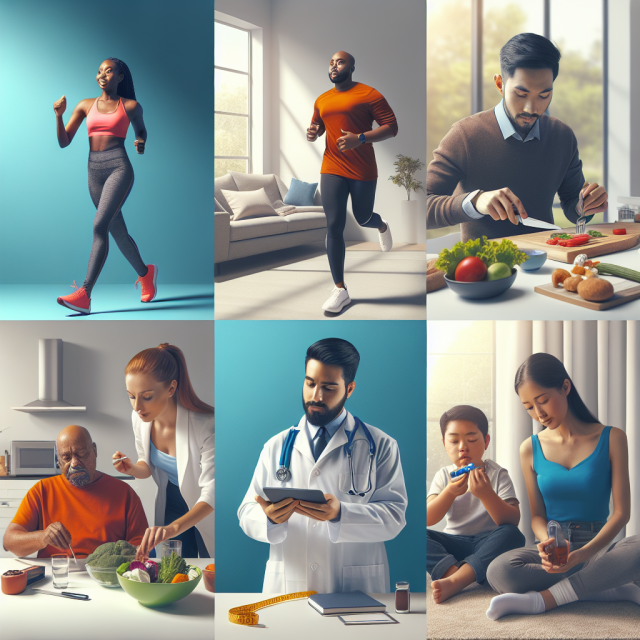Introduction
Prediabetes is a warning sign—a chance to make changes before it turns into Type 2 diabetes. The good news? Research shows that the right diet for prediabetes can reverse insulin resistance, lower blood sugar, and reduce the risk of developing diabetes.
But what should you eat? Is it all about cutting carbs? Should you avoid sugar entirely? The truth is, managing prediabetes isn’t about deprivation—it’s about making smart food choices that nourish your body and keep blood sugar stable.
This guide explores the best foods to prevent Type 2 diabetes naturally, why they work, and how to create a meal plan that supports long-term health.
Table of Contents
| Sr# | Headings |
|---|---|
| 1 | Understanding Prediabetes and Blood Sugar Control |
| 2 | Best Foods to Include in a Diet for Prediabetes |
| 3 | Foods to Avoid to Prevent Type 2 Diabetes |
| 4 | Creating a Sustainable Meal Plan |
Understanding Prediabetes and Blood Sugar Control
Prediabetes means blood sugar levels are higher than normal but not high enough to be diagnosed as Type 2 diabetes. It’s a wake-up call—but one that offers a chance to reverse the condition with lifestyle changes.
How Prediabetes Develops
Prediabetes occurs when the body becomes resistant to insulin, the hormone that helps move sugar into cells for energy. Over time, excess glucose stays in the bloodstream, leading to potential damage to nerves, blood vessels, and organs.
Key Blood Sugar Markers
Doctors diagnose prediabetes using fasting glucose levels and A1C tests:
✔ Fasting blood sugar: 100–125 mg/dL (normal is below 100)
✔ A1C levels: 5.7%–6.4% (6.5% or higher indicates diabetes)
Can Diet Reverse Prediabetes?
Yes! A healthy diet for prediabetes can:
- Improve insulin sensitivity
- Reduce glucose spikes
- Support weight loss and metabolic health
By focusing on whole, nutrient-rich foods, individuals can prevent prediabetes from progressing to Type 2 diabetes.
For additional resources, visit Diabetes in Control.
Best Foods to Include in a Diet for Prediabetes
Eating the right foods can help regulate blood sugar, reduce inflammation, and improve insulin function. Here’s what to focus on:
1. High-Fiber Carbohydrates
Carbs aren’t the enemy—but processed carbs are. The key is choosing slow-digesting, high-fiber carbs that prevent blood sugar spikes.
✔ Best Choices:
- Whole grains (quinoa, barley, oats, brown rice)
- Legumes (lentils, black beans, chickpeas)
- Non-starchy vegetables (spinach, kale, broccoli, bell peppers)
Fiber slows digestion, making you feel full longer and reducing post-meal glucose spikes.
2. Lean Proteins
Protein helps maintain muscle mass, supports metabolism, and stabilizes blood sugar.
✔ Best Choices:
- Fatty fish (salmon, mackerel, sardines – rich in omega-3s)
- Skinless poultry (chicken, turkey)
- Eggs and tofu
Protein also reduces cravings and prevents energy crashes between meals.
3. Healthy Fats
Fat is essential for hormone balance and blood sugar stability. The right fats help reduce insulin resistance and inflammation.
✔ Best Choices:
- Avocados (rich in monounsaturated fats)
- Nuts and seeds (almonds, walnuts, chia seeds, flaxseeds)
- Olive oil and coconut oil
Replacing unhealthy trans fats with these healthy fats lowers the risk of Type 2 diabetes.
By incorporating these foods, patients can control prediabetes naturally while enjoying a nutritious, satisfying diet.
Foods to Avoid to Prevent Type 2 Diabetes
Certain foods can worsen insulin resistance and contribute to blood sugar spikes. These should be minimized or eliminated in a diet for prediabetes.
1. Refined and Processed Carbohydrates
These carbs digest quickly, causing blood sugar spikes and crashes.
❌ Foods to Avoid:
- White bread, white rice, and pasta
- Breakfast cereals with added sugar
- Baked goods and processed snack foods
2. Sugary Beverages
Liquid sugar is absorbed rapidly, leading to insulin resistance over time.
❌ Drinks to Avoid:
- Soda, energy drinks, and fruit juices
- Sweetened coffee and flavored teas
3. Trans Fats and Processed Meats
Trans fats and highly processed meats contribute to inflammation and metabolic issues.
❌ Unhealthy Fats to Avoid:
- Fast food and fried snacks
- Margarine and hydrogenated oils
Limiting these foods can greatly reduce the risk of developing diabetes.
Creating a Sustainable Meal Plan
A realistic, long-term meal plan helps patients stick to healthy habits without feeling deprived.
Sample Day of Eating for Prediabetes
Breakfast: Scrambled eggs with spinach and whole-grain toast
Lunch: Grilled salmon with quinoa and roasted vegetables
Dinner: Chicken stir-fry with brown rice and steamed broccoli
Snacks: Greek yogurt with chia seeds or a handful of almonds
Meal Planning Tips for Success
✔ Plan meals in advance to avoid unhealthy choices.
✔ Balance each meal with fiber, protein, and healthy fats.
✔ Monitor portion sizes to prevent overeating.
By creating a meal plan tailored to individual needs, healthcare professionals can empower patients to make lasting changes.
For more guidance, visit Healthcare.pro.
FAQs
1. Can prediabetes be reversed with diet alone?
Yes! Studies show that a healthy diet combined with exercise can reverse prediabetes and prevent Type 2 diabetes.
2. Is it okay to eat carbs if you have prediabetes?
Yes! But it’s important to choose high-fiber, complex carbs instead of processed, refined ones.
3. How quickly can diet changes improve blood sugar?
Some people see improvements in just a few weeks, while long-term habits create lasting benefits.
4. Can intermittent fasting help with prediabetes?
Some research suggests that intermittent fasting may improve insulin sensitivity, but it’s important to consult a healthcare provider first.
5. What’s the best way to monitor prediabetes at home?
Use a glucometer or continuous glucose monitor (CGM) to track blood sugar trends throughout the day.
This content is not medical advice. For any health issues, always consult a healthcare professional. In an emergency, call 911 or your local emergency services.
